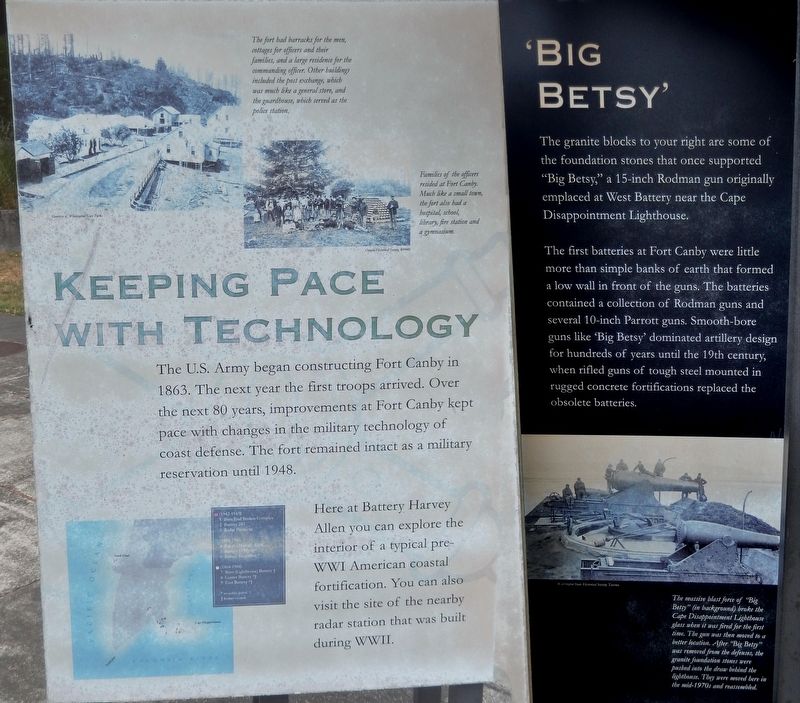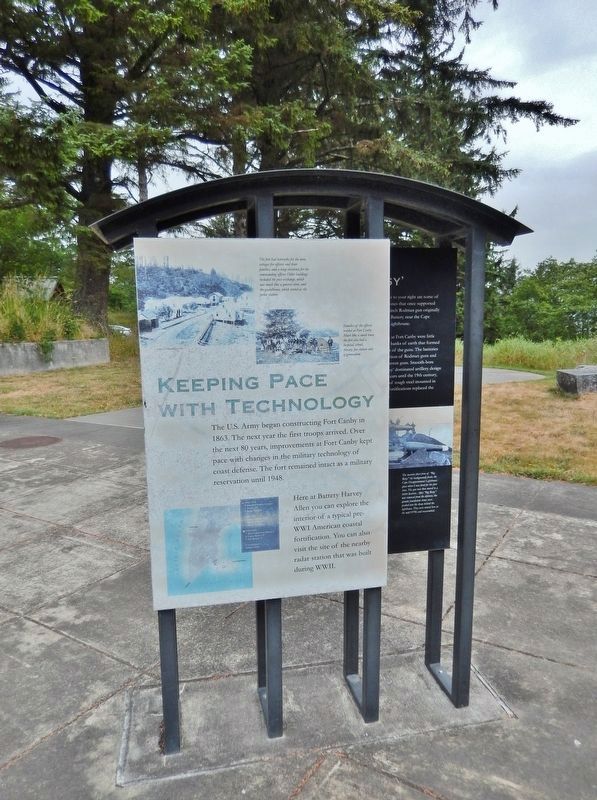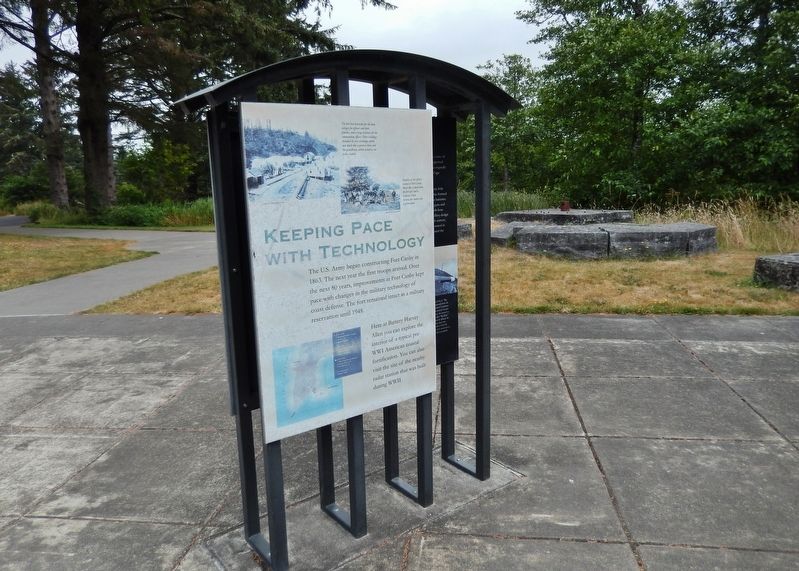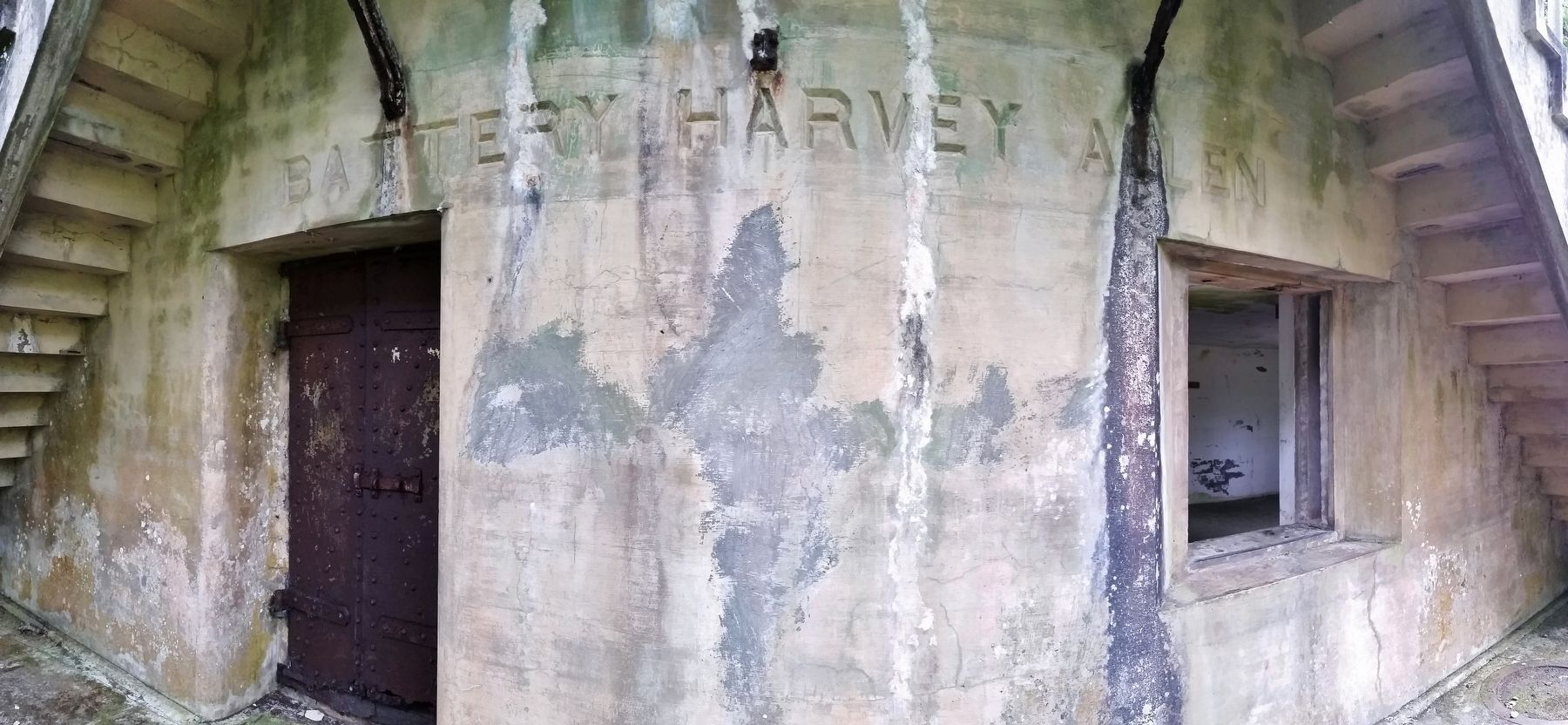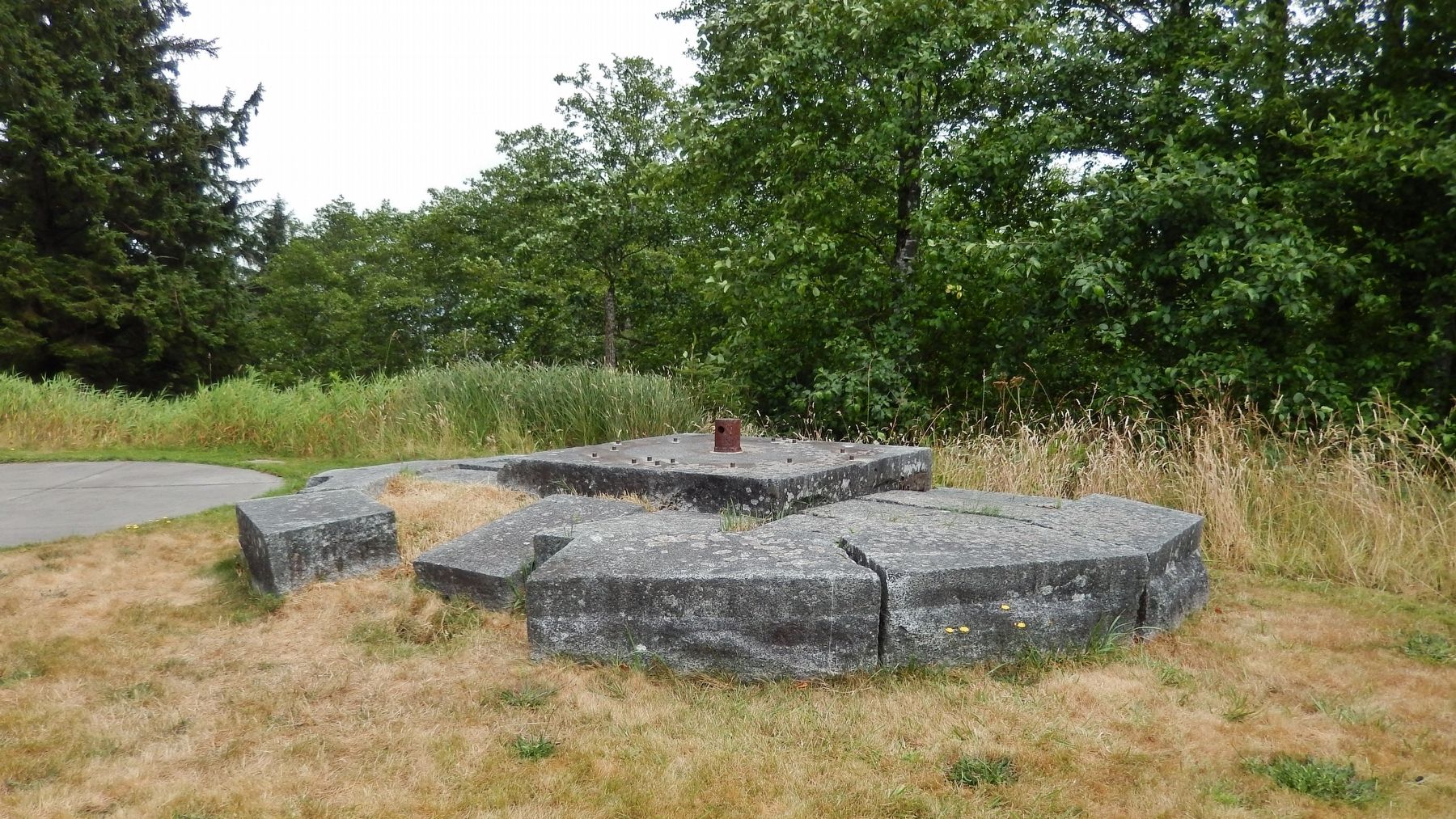Ilwaco in Pacific County, Washington — The American West (Northwest)
Keeping Pace with Technology
Fort Canby
The fort had barracks for the men, cottages for officers and their families, and a large residence for the commanding officer. Other buildings included the post exchange, which was much like a general store, and the guardhouse, which served as the police station.
Families of the officers resided at Fort Canby. Much like a small town, the fort also had a hospital, school, library, fire station and a gymnasium.
The U.S. Army began constructing Fort Canby in 1863. The next year the first troops arrived. Over the next 80 years, improvements at Fort Canby kept pace with changes in the military technology of coast defense. The fort remained intact as a military reservation until 1948.
Here at Battery Harvey Allen you can explore the interior of a typical pre-WWI American coastal fortification. You can also visit the site of the nearby radar station that was built during WWII.
”Big Betsy”
The granite blocks to your right are some of the foundation stones that once supported "Big Betsy," a 15-inch Rodman gun originally emplaced at West Battery near the Cape Disappointment Lighthouse.
The first batteries at Fort Canby were little more than simple banks of earth that formed a low wall in front of the guns. The batteries contained a collection of Rodman guns and several 10-inch Parrott guns. Smooth-bore guns like “Big Betsy” dominated artillery design for hundreds of years until the 19th century, when rifled guns of tough steel mounted in rugged concrete fortifications replaced the obsolete batteries.
Topics. This historical marker is listed in this topic list: Forts and Castles. A significant historical year for this entry is 1863.
Location. 46° 16.691′ N, 124° 3.217′ W. Marker is in Ilwaco, Washington, in Pacific County. Marker can be reached from Cape Disappointment Road, 0.4 miles south of Coast Guard Road when traveling south. This marker is located at the Cape Disappointment Lewis and Clark Interpretive Center. The marker is on the back (north) side of the Interpretive Center, near the parking lot. Touch for map. Marker is in this post office area: Ilwaco WA 98624, United States of America. Touch for directions.
Other nearby markers. At least 8 other markers are within 7 miles of this marker, measured as the crow flies. Fort Canby (here, next to this marker); Lewis and Clark Trail (within shouting distance of this marker); Cape Disappointment Lighthouse (approx. 0.2 miles away); Life of a Lighthouse Keeper (approx. 1.8 miles away); Clamshell Railroad Driving Tour (approx. 2.1 miles away); An Evolving Playground (approx. 2.2 miles away); A Disastrous Year (approx. 2.3 miles away); Battery Pratt (approx. 6.4 miles away in Oregon). Touch for a list and map of all markers in Ilwaco.
More about this marker. Marker consists of two panels on a tall kiosk structure.
Related markers. Click here for a list of markers that are related to this marker. "Big Betsy" 15-inch Rodman gun
Also see . . .
1. Fort Canby.
Fort Canby (1852-1947) - Established in 1863 during the U.S. Civil
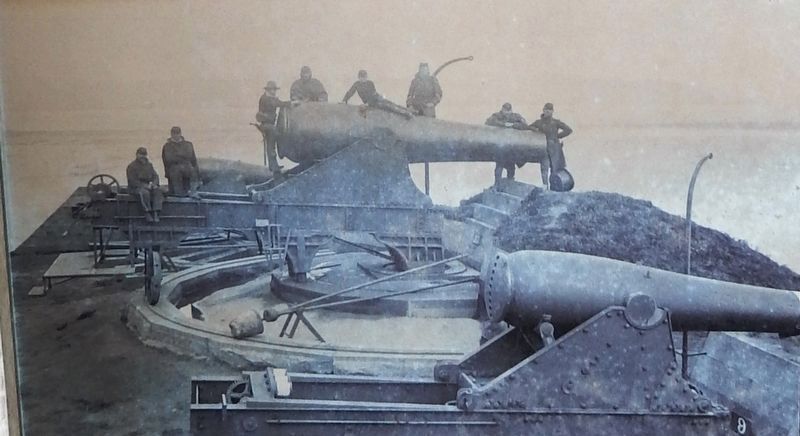
Washington State Historical Society, Tacoma
2. Marker detail: "Big Betsy"
The massive blast force of "Big Betsy" (in background) broke the Cape Disappointment Lighthouse glass when it was fired for the first time.
The gun was then moved to a better location.
After "Big Betsy" was removed from the defenses, the granite foundation stones were pushed into the draw behind the lighthouse.
They were move here in the mid-1970s and reassembled.
2. Fort Canby WWII Radar Site.
Fort Canby WWII Radar Site (1943-1946) - A World War II U.S. Army Radar Site established in 1943. Used to provide fire control information to large caliber (6" and above) coastal gun batteries in the Harbor Defense of the Columbia against enemy warships. Located on Fort Canby, Pacific County, Washington. Closed in 1946. (Submitted on April 19, 2018, by Cosmos Mariner of Cape Canaveral, Florida.)
3. Rodman's Great Guns.
Specifications were impressive. The 15-inch Rodman gun was 15 feet, 10 inches long, with a bore length of 13 feet, 9 inches, or 11 times caliber, a good deal shorter than the general rule. Most black-powder artillery, other than howitzers and mortars, had a bore length of fifteen to twenty times caliber. With an odd bottle-shaped appearance, and the absence of reinforcing rings, something new to artillery, the gun had a maximum outside diameter of four feet. (Submitted on April 20, 2018, by Cosmos Mariner of Cape Canaveral, Florida.)
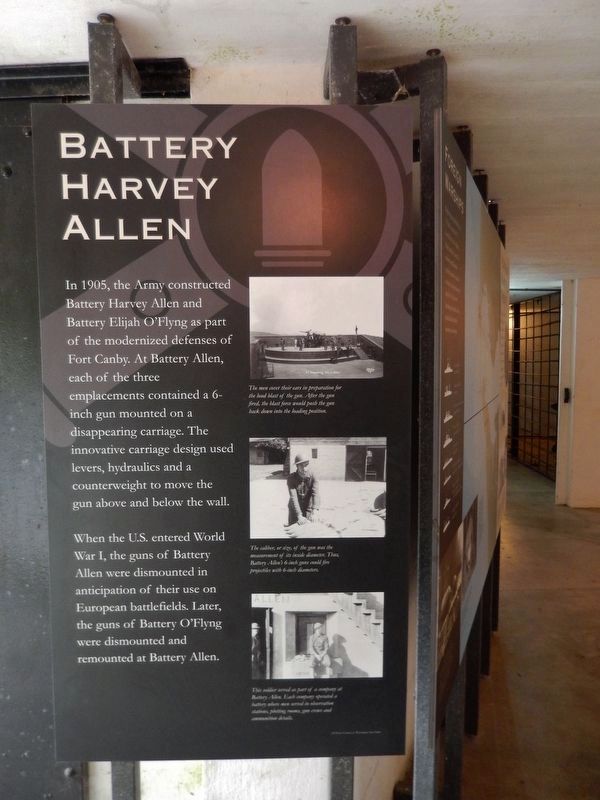
Photographed By Cosmos Mariner, July 10, 2015
5. Bettery Harvery Allen
In 1905, the Army constructed Battery Harvey Allen and Battery Elijah O'Flyng as part of the modernized defenses of Fort Canby.
At Battery Allen, each of the three emplacements contained a 6-inch gun mounted on a disappearing carriage. The innovative carriage design used levers, hydraulics and a counterweight to move the gun above and below the wall.
When the U.S. entered World War I, the guns of Battery Allen were dismounted in anticipation of their use on European battlefields. Later, the guns of Battery O'Flyng were dismounted and remounted at Battery Allen.
When the U.S. entered World War I, the guns of Battery Allen were dismounted in anticipation of their use on European battlefields. Later, the guns of Battery O'Flyng were dismounted and remounted at Battery Allen.
Credits. This page was last revised on April 20, 2018. It was originally submitted on April 19, 2018, by Cosmos Mariner of Cape Canaveral, Florida. This page has been viewed 189 times since then and 10 times this year. Photos: 1, 2, 3, 4, 5. submitted on April 19, 2018, by Cosmos Mariner of Cape Canaveral, Florida. 6. submitted on April 20, 2018, by Cosmos Mariner of Cape Canaveral, Florida. 7. submitted on April 19, 2018, by Cosmos Mariner of Cape Canaveral, Florida. • Andrew Ruppenstein was the editor who published this page.
